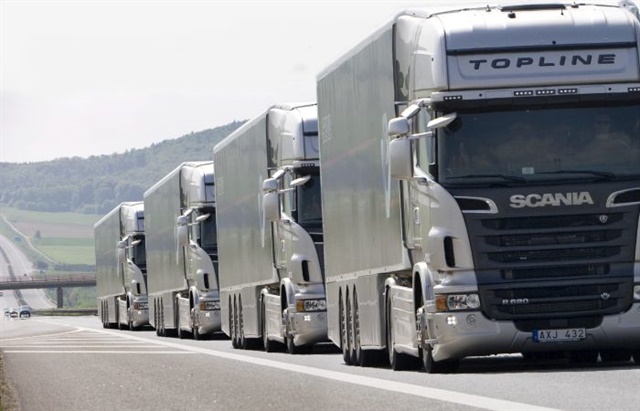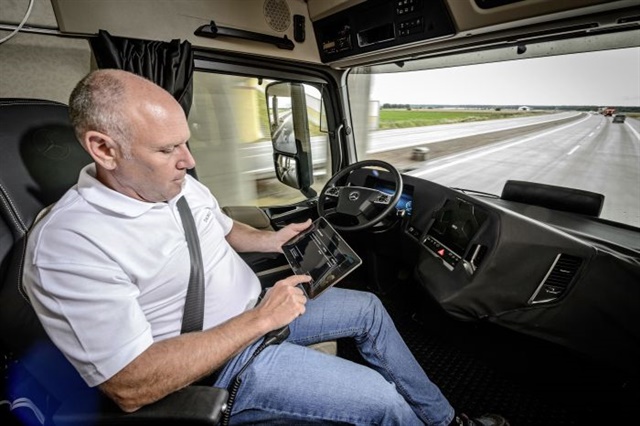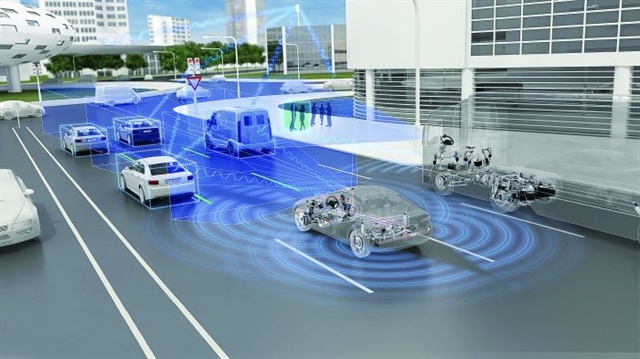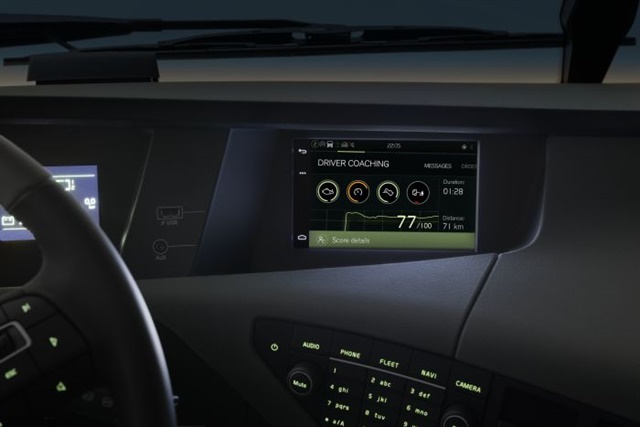
How Network Complexity Killed Water Cooler Collaboration
October 17, 2017
UPS joins BiTA blockchain group hoping to build a centralized shipping ledger worldwide
November 21, 2017Smart Trucks Have Already Arrived

Reprinted from www.truckinginfo.com
Part Seven of the Trucking in the 21st Century Series
September 2017, TruckingInfo.com – Cover Story
The trucks going down the road a decade from now will likely not look drastically different than they do today. And, despite all the hype over autonomous trucks, they probably will still have drivers. It’s what’s going on behind the dashboard and over the air that is truly exciting as we enter a new generation of smart and connected trucks.
Class 8 trucks being introduced today are preloaded with an impressive — and expandable — suite of electronics and wireless communication capabilities. Over the next decade, experts say, those capabilities will exponentially expand the efficiency, safety, productivity, and visibility of commercial trucks hauling freight — in ways that could fundamentally transform trucking and logistics in the 21st century.
The three technologies driving these changes are vehicle connectivity, artificial intelligence, and autonomous operating systems. Many of the systems that will enable these changes are already on trucks today. Over the next five to 10 years, experts say, these systems will become more powerful. They will be able to broadcast and receive data reliably in any location at any time, and they will begin to self-integrate and feed off of each other’s capabilities. Trucks will begin the transformation into rolling computers that can monitor the health of their own disparate operating systems, as well as the cargo they’re carrying, the personnel operating them, and the world around them.
The result will be a flow of real-time information that goes far beyond telematics capabilities today, spilling over into the entire logistics chain.
Integration inside and out
For all the changes coming our way, the outward physical appearance of the trucks themselves is not likely to change much. That’s because the basic mission of these vehicles, the weight they can legally carry, and the legal dimensions they are required to adhere to, is unlikely to change over the coming decade. So if you’re expecting futuristic vehicle styling, the truck of 2027 is bound to be disappointing. Most of the changes with the potential to transform trucking will take place under the vehicle’s skin.
“Trucks 10 years from now will be greener and more business-friendly than ever before,” says Sandeep Kar, who explored the issue during his years as a transportation analyst with investment and research firm Frost & Sullivan. (He’s now chief strategy officer at FleetComplete.) Fuel will remain a fleet’s biggest operational cost, continuing the current push for fuel economy and opening up new drivetrain options. “I think we will start to see the first electric drivetrain components added to conventional diesel powertrains over the next decade,” Kar says.
Powertrain enhancements are a given going forward, says Derek Rotz, senior manager, advanced engineering, Daimler Trucks North America. But as this happens, he’s looking for more overall system integration throughout vehicles in day-to-day operations.
“We will start to see powertrain enhancements and improvements in combustion efficiencies start to work with driver assistance- and active safety-systems,” Rotz says. “Cameras and radar systems will begin to work with onboard electronic control systems and the powertrain itself. Over time, every system on a truck, regardless of its specific purpose, will start to flow together, share data, and operate as a fully integrated vehicle.”
Sensors and cameras will track moving and stationary objects and feed that data to the automated manual transmission. The transmission will use that information, combined with data from GPS systems, mapping systems, internal route memorization, lateral controls and other systems, to shift smoothly, optimize fuel economy and keep a driver fully alert at all times.
“In the near future, every single aspect of driving a commercial truck will be influenced and affected by these systems constantly in real time,” Rotz says.
Connectivity: The real revolution
Yet integrating the powertrain, safety and other systems — as important and valuable as they will surely be for fleets — aren’t the game-changer. It’s the fact that the near-term future truck will be a fully connected and constantly communicating mobile data collection center.
The truck of the future will be interconnected to other vehicles, the local infrastructure and the cloud, says Bryan Johnson, senior manager, corporate communications, for vehicle systems supplier ZF. He says components inside the truck also will be interconnected, allowing new assistant functions to emerge that are already considerably increasing safety, efficiency and comfort.
Important in the process is transforming formerly passive systems into electrified, controllable-by-wire ones.
“At ZF, we refer to such systems as intelligent mechanical systems,” Johnson says. “The truck of the future will have sensors, such as cameras, radar and laser technology on board, which will provide environment recognition. And it will be equipped with artificial intelligence thanks to supercomputing systems like ZF ProAI. And all logistics processes are also connected. Versatile, open telematics systems, such as ZF’s Openmatics, will function as connectivity units for GPS and cloud navigation as well as easy management of freight and fleets, including maintenance.”
As this shift occurs, it will mark a departure in how trucks are viewed by carriers. “For over a century, fleets have looked at a vehicle and said, ‘Here’s a truck. What can I do with it?’” Kar says. “Soon, fleets will look at a connected truck and say, ‘Here’s a truck. What can it do for me and my business?’”
Trucking in the past was a vital, but boring, industry, Kar says. “Suddenly, the coolest kids in tech are interested in trucking. You see Jeff Bezos, Elon Musk, Bill Gates, Apple, Uber, Intel and a whole host of cutting-edge tech companies and people suddenly interested in this industry — because it is an outdated and inefficient industry that can and must change with the times.”
New truck models already are armed with sensors that monitor vehicle systems and broadcast faults to modern telematics crisis centers around the country operated by OEMs and large dealer networks. But, it’s a mere toe in the water compared to the oceans of data that will soon be transmitted.
“In the very near future, the sensors present on commercial vehicles are going to explode in number, as will the number of onboard computers handling the information they generate,” says Jerry Robertson, chief technical officer, Bolt Systems, developers and suppliers of internet-based fleet management and dispatch software. We don’t look twice now at sensors on AMTs, fuel pumps, oil coolers, radiators and other critical powertrain components. Soon, Robertson says, “it will be a challenge to find any system on a truck that is not being monitored and transmitting data. “
In fact, Daimler says its trucks in Europe already include approximately 400 sensors and are fully connected with software including 130 millions lines of code — more than a passenger jet.
The proliferation of sensors won’t stop with vehicle systems, adds Leo Jolicoeur, chief operating officer for Drivewyze, which markets weigh station bypass communication systems. “Very soon, we’re going to see sensors on drivers, on freight itself, in reefers monitoring cargo temperatures and on exhaust systems measuring emissions,” he predicts. “Trucks are evolving into rolling connected information hubs with massive potential as members of a fully meshed, nationwide or even worldwide communication network. Very quickly, the information collected and transmitted by trucks will make our roads safer and traffic flow more efficient — with full transparency of a shipment from all perspectives. The shipper, the fleet, the driver, law enforcement and municipalities, and borders and customs officials en route to the receiver will know any aspect of a shipment in real time.”
 |
Ten years ago, truck and engine makers were adding a brand-new electronic control module to trucks to help manage exhaust aftertreatment systems required by new federal emissions regulations, says Jason Krajewski, manager of DTNA’s connected vehicle insight team. “Since then, sensors and ECMs have been added regularly, with three or four new powerful number crunchers added in the past couple of years to handle data from new mapping systems and capacity for cameras, radar and active vehicle safety systems. Given this rate, I think it’s safe to say that the number of sensors and ECMs will easily double over the next decade.”
But, Krajewski adds, trucks are also increasingly leveraging other data storage systems — namely the cloud — which is undergoing an organic evolution of its own. “Initially, we saw various providers establish their own proprietary cloud networks,” he says. “Apple had a cloud. AT&T had a cloud. And so on. But now, these cloud networks are all talking to one another. And with mobile phones everywhere now, the cloud has become pretty much everywhere, with all of us constantly feeding information into it.” Add the concept of everything from trucks to smartphones being connected this way, and you have the Internet of Things.
In the short term for trucks, Krajewski says this means less memory capacity required onboard. A connected truck can simply download the information or data it needs on a moment’s notice. But it’s the long-term implications of this shift that really showcase the incredible power of connected trucks.
As more vehicle sensors come on line, collecting and transmitting data, more and more users inside and outside of the trucking industry will begin to access and leverage that data. A municipality, for example, may see a series of lane departure warnings from a specific segment of roadway and send a crew out to check for debris in the road. Sensors on truck suspensions might soon send multiple impact alerts from another section of a highway, indicating a pothole that needs to be patched. Retailers will be able to update inventory in real time, and package updates will be accurate down to a specific mile-marker and vehicle speed en route, with real time data on weather, traffic and accidents continually updating a shipment’s delivery time.
This is why connected trucks will be so transformative, Kar says. “Connectivity solves many of trucking’s short-term problems right away. It makes the job of driving a truck easier and less stressful, because it is safer and drivers can communicate with their families at home. They will also be able to work on side projects or use Uber-style freight apps to make more money, which makes a fleet more money. Shippers are happy. Customers are happy. And the freight was moved far more efficiently with less fuel burned and fewer emissions emitted into the atmosphere. Connected trucks are a win/win/win/win/win for everyone in trucking, our economy, and our nation as a whole.”
Smart trucks and maintenance
A few years ago, it was cutting edge technology to have a vehicle detect a mechanical problem, then beam information about it to a remote location, where the data would be crunched and decisions made on how to handle the situation. Today, we’re seeing the rise of new disciplines of analytics and predictive failure modeling to keep trucks up and running.
Trucks are getting smarter all the time, and that “intelligence” rate is going to grow exponentially over the next five years, says Eric Witty, vice president of product management for PeopleNet, a provider of fleet management and communications technology. “Telematics systems are already moving toward more diagnostic and predictive maintenance models,” he says. “Once you combine these telematics systems with the enormous amounts of data being captured and transmitted from the trucks, you have an enormous backlog of data that allows fleets to easily establish trends on both macro- and micro-levels, as well as set solid statistical models for virtually any maintenance issue imaginable.”
As a result, Witty says, fleets will soon move to an “edge analytics” concept of maintenance, where vehicles will be able to keep running right up to the edge of predicted failures, have the issues dealt with before they actually break down, and then get back on the road as quickly as possible. “Smartphones and technician diagnostic tools are going to be on the edge of maintenance in the future,” he adds. “The truck will be smart enough to look at the data it’s generated and issue instructions for the necessary repairs.”
“The electronic infrastructure on trucks are already evolving to make room for analytics,” says Bill Roberts, director of Global Manufacturing and Supply Chain Practices for SAS, a global provider of logistics, transportation and supply chain analytics. “Smart trucks now are not just about patterns we can detect like fault codes,” he says. “That doesn’t drive your fleet’s value chain anymore. But a modern, smart truck can predict failures and self-diagnose problems while making sure it completes its run and has parts and service scheduled in a timely fashion that lets it get repaired and get back to work. The days of getting a failed turbo repaired, and then putting the truck back in the shop two weeks later for an oil change, are ending. The truck will let the service provider know to perform all that work at the same time.”
Smart trucks will always be smart and always be updated, Roberts says. They will “learn” from their experiences with specific routes or weather conditions and transmit that data back to fleets and OEMs. “Today, we’re used to thinking about trucks in terms of fleets and then as individual assets,” he says. “That will change as we learn new information about how trucks individually and fleets as a whole perform in a whole host of different operating environments. Fleet managers will soon be able to identify problems, operational issues or opportunities looking at how trucks behave and understanding the causes behind that behavior like never before.”
Beyond maintenance and downtime issues, smart trucks will also be proactive in making sure they have the capability to operate in the most efficient possible manner at all times, whether it’s “learning” specific routes to optimize AMT shift points, coasting in neutral and throttle inputs to maximize fuel economy, recognizing that it has crossed the border into Canada and setting a limit on how fast it can go, or updating powertrain parameters to better deal with changing geography along a route.
“You don’t have to look too far out to see this happening,” Kar says. “Just look at the new Cummins over-the-air updates available now. As long as the truck has a good Wi-Fi connection, Cummins can send you updates today to optimize that truck for a growing list of long- and regional-haul applications.”
Roberts notes that when over-the-air updates first appeared, trucks could reflash drivetrain controls in three or four hours. “That’s already no good,” he notes. “That’s the better part of a day down. And OEMs know they will have to do better.”
They already are, according to Krajewski. He says a new, faster, update system is in final testing at DTNA and will be available soon on the new Freightliner Cascadia. “It will be a huge game-changer for drivers and fleets,” he predicts. “To make updates while driving requires a whole new set of onboard processors. And I think we will go there someday. But our next system will notify fleets of software updates. They will send a message to the driver, who will confirm while driving. Then once the truck is stopped with the key off, the powertrain will automatically update its software. And 45 minutes later, it will be ready to go back into service.”
 |
Limited autonomous operations
The final piece of the smart and connected truck is the much-discussed and much-feared advent of autonomous driving technology. But for all the angst surrounding the concept of “driverless trucks” roaming the highways, the fact is, autonomous vehicle technology is already available on new trucks. That trend will accelerate rapidly as truck platooning transitions from the developmental stage to real-world fleet operations.
“Often, what’s claimed to be autonomous (no driver) functionality is really an automated (driver present) functionality,” notes Fred Andersky, director of government and industry affairs at Bendix Commercial Vehicle Systems. He believes truly driverless trucks are not likely to hit roads until 2030 at the earliest and not reach critical mass (greater than 50% on the road) until the 2050 timeframe.
“Platooning today, as it appears in development, will still have two drivers for the foreseeable future,” Andersky says. “I think yard maneuvering — such as trailer sorting or dropping a truck and letting it find its way to the loading dock — are likely the first autonomous fleet operations.” And indeed, companies such as component makers Eaton and ZF are already working on self-docking systems. That, he says, will be followed by “niche autonomous vehicles, such as driverless interstate vehicles that move cargo on the interstate in a driverless fashion, but still need to be driven to the interstate and picked up at the arrival point — much the way triple trailer operations are broken down at points on limited-access highways to enable local delivery.”
Josh Switkes largely agrees with Andersky’s assessment. He’s president and CEO at Peloton, which is developing truck platooning technology, where some of today’s automation-enabling technologies and connectivity will allow trucks to follow each other more closely and reap fuel-economy benefits. Some demonstrations have also been done in Europe using hands-off automation in the following trucks in a platoon.
“The key to automated vehicle deployment over the next decade will be in limited, controlled situations,” Switkes says. “From that standpoint, I don’t think it’s a matter of when will we see autonomous vehicles, but how widespread they will be at any given point in that timeframe.”
Switkes thinks this will mean the deployment of shuttle vehicles running set routes in highly constrained environments. “From there, I think their use will start to increase, and more and more operations will move to autonomous technology. But even after 10 years, we’ll still be looking at a tiny percentage of freight being hauled.”
Far from replacing drivers, Switkes thinks that over the next decade, fleets will increasingly recognize autonomous technology as a means of assisting drivers and making them safer. This is a view shared by Wade Long, director of product marketing for Volvo Trucks North America. “When you look at lane departure warnings, forward collision mitigation systems, as well as adaptive and predictive cruise control systems, you’re already talking about partial and conditional automated vehicle control,” he says. “Platooning is the obvious next step forward for autonomous technology. And I think in 10 years’ time, we’ll be at a point where we see limited autonomous vehicle control — in traffic congestion, for example, where the truck monitors the truck as it moves down the road and the driver can do other activities.”
As for platooning, it will likely be the first instance many Americans in more isolated parts of the country get to see autonomous technologies working in the real world. Switkes says Peloton is largely ready to go and currently wrapping up the final tests of its first-generation truck platooning technology. “We’re finishing up our final safety evaluations now and preparing an initial launch for certain customers in certain markets.”
Switkes says platooning will offer fleets significant fuel savings during highway runs, but insists that the technology’s true value is in safety. “When people talk about driverless trucks, I think they really miss out on the fact that autonomous technology will offer great benefits to fleets long before we get to the point where there’s not a human sitting behind the steering wheel,” he says. “Very soon, we’ll be able to demonstrate how cloud data optimization enables platooning, and the big economic impact platooning will have for fleets in terms of lowering operating costs, increasing freight and fuel efficiencies, and making them more competitive. Once those concepts are proven out, we’ll see the industry take later steps leading to higher levels of automation. We see that process happening over the next few years and believe that a decade from now, platooning by fleets will be widespread and common.”
So in many ways, the truck of the future is here now. The coming months will likely see new vehicles, technologies and applications come to light that will only further the concept of smart, connected trucks capable of taking limited tasks away from their drivers. Indeed, it seems safe to say that going forward, these futuristic technologies will simply be considered standard equipment on commercial vehicles. And the question for fleets will move from, “Do I want a smart, connected truck?” to: “Here are my new, smart, connected trucks. How do I get the most out of them?”
Note: This story has been updated from the print version to include the current title of Sandeep Kar, who changed jobs shortly after we interviewed him for this article.





